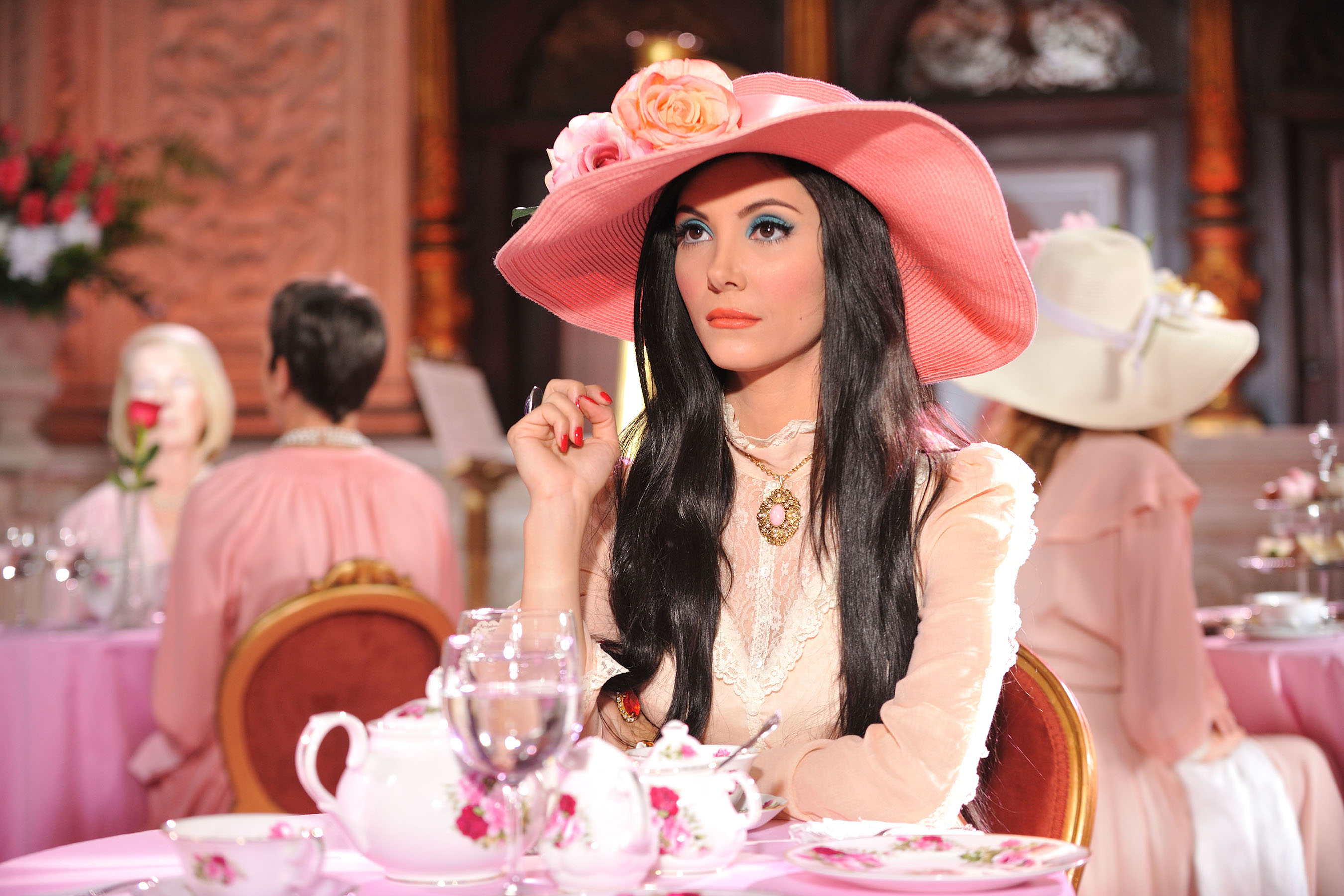Anna Biller's THE LOVE WITCH
 Friday, November 11, 2016 at 08:20PM
Friday, November 11, 2016 at 08:20PM When I say I’m in love you best believe I'm in love L U V
 Samantha Robinson as Elaine (Oscilloscope Laboratories)
Samantha Robinson as Elaine (Oscilloscope Laboratories)
You wouldn’t want to mistake The Love Witch for an updating of or commentary on Beyond The Valley of the Dolls. Beyond is a camp evisceration of every sacred Sunset Strip-era trope – groovy language, bell-bottoms, LSD, free love and even rock and roll – delivered in the guise of an exploitation film. Its enduring pleasure derives from the considerable tension between director Russ Meyer’s devotion to exploitation and his apparent lack of awareness that the screenplay exploits his devotion in the service of self-parody.
Anna Biller’s The Love Witch shares with Beyond only naked young women, post-Swinging London Cleopatra eye makeup, a Kodachrome candy-apple color palette, that super-glossy, high-key early ‘70’s lighting and architectural hair. That’s it.
The Love Witch is not an exploitation film. It’s not camp. It’s a witty, endearing, meticulous, double-helix deconstruction and deadpan celebration of the cinematic presentation of gender, seduction, narcissism, self-delusion, love, “love” and naked young women. If it seems for brief moments like an exploitation film, that’s the camouflage Biller wears while hunting bigger game. Feeling Biller tiptoe up to the edge of camp and exploitation – a tightrope she walks with glee – never lessens the contradictory emotions or the political, cinematic and romantic considerations the film evokes in ways you cannot name. Those considerations and emotions never lessen the fun.
Biller triggers your detached intellect even as you immerse in and savor, for example, star Samantha Robinson’s red Mustang convertible, fantastically tacky paintings or honeyed skin. Your interest in the plot matches the director’s. When she vests, you feel the suspense. When she shifts priorities, so do you. For much of the film, plot and ideas interweave and prove equally compelling. After a while, the plot becomes secondary and that’s fine.
Biller’s mise en scene is incantory – it puts you in another state. Or, another world, one entirely constructed by Biller, who made the costumes, built the sets, composed the music and wrote the screenplay. According to an interview in The LA Weekly, Biller took six months to hook a pentagram witchcraft rug because she couldn’t find one she wanted. Her years-long investment in her vision pays off in that each moment and dialogue exchange – no matter how casual the action – seems incongruously crucial.
 Anna Biller's handmade mise-en-scene (Oscilloscope Laboratories)
Anna Biller's handmade mise-en-scene (Oscilloscope Laboratories)
Samantha Robinson plays Elaine, a love-starved witch. As she desperately contorts herself into her projection of what every man wants, Elaine’s unaddressed rage at those contortions leads her to create love potions that kill the men she seduces. Or worse – because Elaine accurately manifests their fantasies – the potions reduce them to babbling emotional wrecks. And as soon as a man falls for her or weeps or conveys need, Elaine has but a single thought: “What a pussy!”
The hunter here is rarely captured by the game. And why should she be? The guys revert to children any time they express their precious feelings. Biller shows an impressive grasp of the horror of 1970s men’s hair and beards. The men are off, somehow; they’re all hairy dipshits. Among themselves, the women discuss emotions and desires calmly. Then the guys show up with their insistence on being in charge and it’s clear they’re the lesser beings. Elaine’s self-esteem issues mean she can no more “be herself” around a guy than she can stop fucking down. Because she can’t, when her lovers kick the bucket, she seldom experiences loss.
But when she does, Biller flips the switch. Elaine’s grieving brings forth the primal and chthonic no witch saga can exist without. She creates a totem, a bottle of her urine in which float her used tampons. It’s a measure of Elaine’s tragic cluelessness about the male psyche that she cannot fathom why the (male) cops freak at the sight of such a thing. She attributes their disgust to an irrational fear of witchcraft.
Though she’s been compared to many exploitation goddesses, Elaine strongly evokes Celeste Yarnall in 1971’s The Velvet Vampire, directed by Stephanie Rothman and co-starring Michael Blodgett, the iconic Lance Rocke in Beyond. Elaine has Celeste’s wide, staring eyes, preternatural cool and seductive remove. Biller’s evocation of past low-rent cinema is never smirking or condescending. Quite the contrary. It’s Biller’s sincere love of the genre that make what could be awkward moments genuinely moving.
Elaine and one beau come upon a Renaissance fair. Everyone recognizes their connection. The fair people lovingly clothe Elaine and her guy in gleaming white and marry them in a mock wedding as Renaissance fair-type music plays. It should be unspeakably cheesy. Well, it is unspeakably cheesy because Elaine’s romantic delusions default to cheese. But Biller’s affection for her story and its players turn the scene into an almost heartbreaking metaphor of the distance between our dreams of romance and its reality.
 "Make our dreams real!" (Oscilloscope Laboratories)
"Make our dreams real!" (Oscilloscope Laboratories)
The Love Witch opens tonight - November 11th - at, among other venues - LA's NUART theatre, where Anna Biller will hold a Q & A at 7PM.

